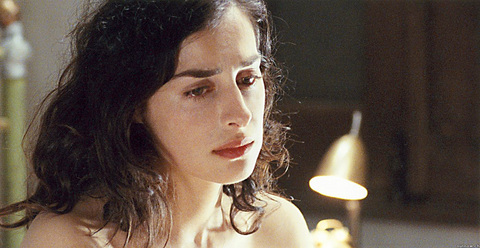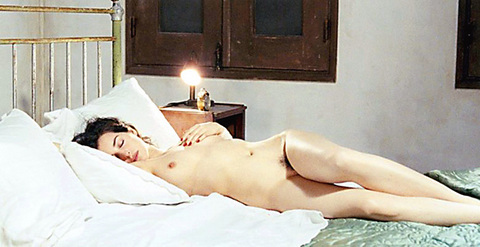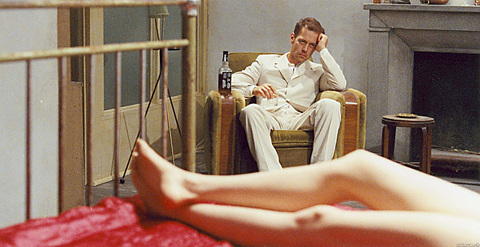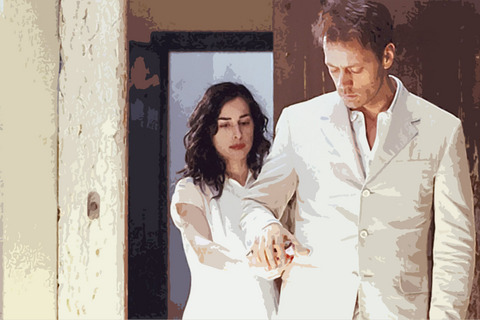For almost three decades, the occasionally brilliant, sometimes maddening French filmmaker Catherine Breillat has created a startlingly original body of films about female sexuality. Like Freud, Breillat is fascinated by the question, What do women want? For Freud the answer was in the Oedipal complex and the little girl's realization that she is, as he put it, a failed boy. Anatomy was destiny and more or less end of story. For Breillat, anatomy may be destiny, but it has also been the impetus to an ongoing story about men and women at play and at war in the field of desire.
The title of Breillat's latest provocation, Anatomy of Hell, which she adapted from her book Pornocracy, indicates that Breillat has yet to tire of Freud's question. In this film, alas, it appears that the question may have finally exhausted her resources and maybe her sense. Once again, she gives us a man and a woman engaged in a bruising slugfest hinged to sexual difference. This time the battleground is an artfully dilapidated chateau of the sort that is familiar from old horror movies and gauzy fashion magazine layouts, and the combatants are a woman identified only as "the girl,'' and played by the French actress Amira Casar, and "the guy,'' played by the Italian pornography star Rocco Siffredi, a sculptured slab whose talents are almost exclusively instrumental.
The two meet cute Breillat-style when the girl desultorily takes a razor blade to one of her wrists in the bathroom of a gay disco. After the guy helps with her wounds, she propositions him: in return for money, he will spend four evenings with her. Glazed with boredom, stupidity or perhaps just numb from all that dancing, he agrees, and the unlikely duo embark on a round of anguished talk and some bad sex. Editorial discretion limits what I can say about the carnal encounters, save that they are graphic, at times clinical in aspect and awkwardly choreographed. Unpleasure rather than pleasure is the name of Breillat's game, which I assume explains the already-infamous scene in which a garden tool suddenly appears where no garden tool should.

PHOTOS: NY TIMES
The rest of the film is equally and painfully foolish. On their first night, the girl leads the guy into a bedroom, whereupon she strips off her clothes and assumes a supine position that invokes such classic nudes as Manet's Olympia. In that painting of a prostitute, her maid and an incurious cat, which shocked Paris when it was unveiled in 1865, Manet created a radically desentimentalized and defiantly independent image of female sexuality. Staring out from the canvas, the prostitute appears as free of shame as of clothes and ready for anything. Breillat's nude, by contrast, directs her gaze outward with an air of grudging petulance, as if she were weary of having to haul herself (yet again) onto this altar of female degradation.
Although some of Breillat's films, including 36 Fillette and Fat Girl, convey an uncomfortably raw sense of the real world in their vibe and preoccupations, other of her films traffic in a deadpan surrealism that recalls a late-period if less amusing Luis Bunuel. As in Breillat's similarly themed and more successful outrage Romance, the lead actress's performance in Anatomy of Hell is almost entirely drained of affect; Casar is as limp as a rag doll and just as expressive. As he did in Romance, Siffredi's appearance in the new film seems predicated on his Pavlovian physicality. The characters' dialogue, in turn, is so stilted and ridiculous that it is impossible to know if Breillat is attempting some kind of Brechtian alienation effect or has just gone off the deep end.
The film's philosophy of the bedroom suggests this second possibility. "The fragility of female flesh inspires disgust or brutality,'' the man says on seeing the woman naked. "Women depend on one or the other.'' To which the woman, in turn, asks: "What should we fear more? Nothingness or brutality?'' It should be easy to dismiss this Manichaeism, to argue that between nothingness and brutality there exists a world of possibility for men and women. But such arguments have no place in this movie because Breillat doesn't just recycle musty ideas about men and women's essential, bestial, obscene natures; she seeks male approval and then punishes her on-screen avatar for seeking such approval. That Breillat uses a gay man to indulge such masochism, a man who very likely wouldn't give a woman a second look, is especially gutless.

This is a depressing turn for a filmmaker who has always hewed to her own course. It has been Breillat's independence that has made her work so much more interesting than many films in what the critic James Quandt has christened the New French Extremity. Heavy on sex and death and sometimes some frenzied combination of the two, these films include misanthropic anti-entertainments like Gaspar Noe's Irreversible and Bruno Dumont's Twentynine Palms, which both seek to punish their audiences as brutally as their characters and exploit rape to justify their nihilism. Breillat shares with these filmmakers an almost juvenile interest in rocking bourgeois sensibilities, but in contrast to someone like Noe, she has always used shock to express ideas, not to camouflage an absence of ideas.
In her earlier features, most of which serve as a better introduction to this gifted filmmaker than this film, Breillat's disregard for social pieties and insistence on tearing away the veil from female sexuality has made for galvanizing viewing. I can think of few other filmmakers who have so fearlessly risked legitimacy (and laughter) to pursue their personal vision. At her best, Breillat comes to each of her films as naked as any of her female characters; she strips herself bare for her art and beliefs, and it is this passionate commitment that has helped gloss over her occasional missteps. But Anatomy of Hell is more than a lapse; it is a brutal self-parody of a filmmaker who, having stripped down to the nitty-gritty once too often, may finally have nothing left to show.



The canonical shot of an East Asian city is a night skyline studded with towering apartment and office buildings, bright with neon and plastic signage, a landscape of energy and modernity. Another classic image is the same city seen from above, in which identical apartment towers march across the city, spilling out over nearby geography, like stylized soldiers colonizing new territory in a board game. Densely populated dynamic conurbations of money, technological innovation and convenience, it is hard to see the cities of East Asia as what they truly are: necropolises. Why is this? The East Asian development model, with

June 16 to June 22 The following flyer appeared on the streets of Hsinchu on June 12, 1895: “Taipei has already fallen to the Japanese barbarians, who have brought great misery to our land and people. We heard that the Japanese occupiers will tax our gardens, our houses, our bodies, and even our chickens, dogs, cows and pigs. They wear their hair wild, carve their teeth, tattoo their foreheads, wear strange clothes and speak a strange language. How can we be ruled by such people?” Posted by civilian militia leader Wu Tang-hsing (吳湯興), it was a call to arms to retake

This is a deeply unsettling period in Taiwan. Uncertainties are everywhere while everyone waits for a small army of other shoes to drop on nearly every front. During challenging times, interesting political changes can happen, yet all three major political parties are beset with scandals, strife and self-inflicted wounds. As the ruling party, the Democratic Progressive Party (DPP) is held accountable for not only the challenges to the party, but also the nation. Taiwan is geopolitically and economically under threat. Domestically, the administration is under siege by the opposition-controlled legislature and growing discontent with what opponents characterize as arrogant, autocratic

Desperate dads meet in car parks to exchange packets; exhausted parents slip it into their kids’ drinks; families wait months for prescriptions buy it “off label.” But is it worth the risk? “The first time I gave him a gummy, I thought, ‘Oh my God, have I killed him?’ He just passed out in front of the TV. That never happens.” Jen remembers giving her son, David, six, melatonin to help him sleep. She got them from a friend, a pediatrician who gave them to her own child. “It was sort of hilarious. She had half a tub of gummies,